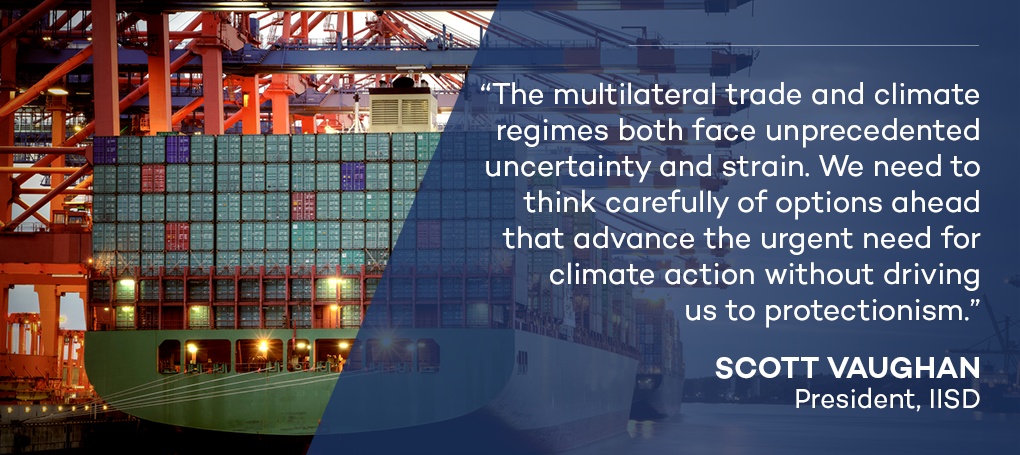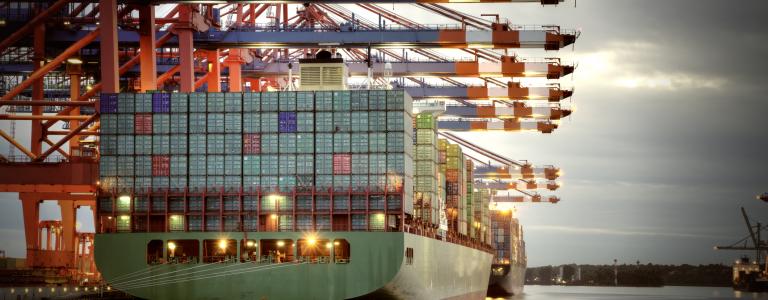Carbon Without Borders: Can trade policy support ambitious climate action?
The multilateral trade and climate regimes both face unprecedented uncertainty and strain. How should countries advance the urgent need for climate action without resorting to protectionism?
You can always see it coming, but you can never stop it.
Cowboy Junkies, “Bea’s Song”
Today, the European Parliament approved two historic agreements. First, they agreed to strengthen the EU climate plan. Hopefully, this will reinforce the EU emissions trading system (ETS), which has languished for the past decade due to problems of its initial design, an early over-allocation of free credits and a price stalled below EUR 10 per tonne.
The second vote in today’s European Parliament saw the approval of the Canada–Europe Comprehensive Economic and Trade Agreement (CETA), which signals a new generation of comprehensive trade and investment policy liberalization.
That both a climate and trade vote occur on the same day is ominous. While the European Parliament explicitly rejected the Commission’s proposal to include a border carbon adjustment, the drumbeat of demands to shield imports based on carbon action will undoubtedly grow louder in the weeks before the issue reappears before the Council of Ministers.

Earlier this week, the Chairman of ArcelorMittal—Europe’s largest steel manufacturer—called on Brussels to introduce a border carbon adjustment, arguing that without an adjustment at the border, countries with weaker or non-existent carbon measures will have an unfair cost advantage compared to European workers. The argument went straight to anxiety and a core grievance in many western democracies, by arguing that with a tax on imports, more than 300,000 European steel jobs could vanish.
Last week, American leaders led by James Baker called for a USD 40 per tonne carbon tax, and a border carbon adjustment scheme to shield U.S. industries from those states that have either no or lower carbon taxes.
The urgent question now concerns how the trade system, reeling from calls for protectionism, will approach this fundamental question of climate and trade policy. Can trade policy support ambitious climate action?
There is no question that the World Trade Organization (WTO) allows countries to condition or block the entry of thousands of goods that fail to meet domestic environmental, public health or safety standards. For example, countries disallow imports of goods that contain leaded paint or that fail to meet minimum energy efficiency standards, provided their domestic goods are treated in the same way. On fiscal measures, the WTO (in GATT Article II), allows different kinds of border tax policies to smooth out differences in fiscal rates, permits some subsidies, and allows scope for trade remedies to redress differences.1
What has paralyzed WTO discussions around environmental standards is not related to specifications embedded in the physical aspects of the product (such as leaded paint) but rather characteristics of production. That is, what kind of energy systems or chemicals were used in production, but that cannot be tested at the border based on physical inspections. Several high-profile WTO legal disputes in the 1990s involved environmental production-process methods relating to marine life protection. One country (the United States) demanded that its domestic production methods—codified through law to safeguard dolphins and turtles—must be applied to all countries hoping to gain access to the lucrative U.S. market. It lost each case.
After decades of debate in committees, the WTO hoped the day would never come when climate change would be used to condition market access and equalize climate action. Part of its misgivings relate to the scope and complexity of possible action. Could winter vegetables that rely on solar-heated greenhouses have preferential import tariffs compared to those grown in greenhouses heated from coal-fired energy sources? And if the WTO allowed this practice, how could would it distinguish in tax treatment a carbon-intensive tomato, automobile, aircraft, smart phone, tonne of steel, cement, aluminum, iron ore or other imports from their lower-carbon or carbon-taxed equivalents?
That day has arrived. Others sectors will surely be lining up behind ArcelorMitall, waiting for similar treatment to shield them from lower-cost producers with no or lower carbon pricing or equivalent measures.
Unfortunately, WTO committees will not be a source of thoughtful policy here. Instead, the WTO Trade Monitoring Reports2 will be an important resource for tracking increases in the use of trade measures. Like others, IISD will be watching the trends in this monitoring system.
Calls for border tax adjustment are hardly isolated to climate change, and there is no doubt a convergence of some interests. The Trump White House has hinted at sweeping border adjustments, vacillating between systemic measures to offset differences with countries that have lower corporate tax rates than promised, to a 20 per cent tariff aimed at specific countries like Mexico and China.
The complexity of these different demands is stunning. Would Europe leverage its border tax adjustment not only at China, which has introduced bold climate action, but also at the United States? How would Brussels approach those jurisdictions like Canada, with a proposed carbon price but lower initial rate than EUR 30 per tonne?
It is very likely the question of carbon border adjustment will end up as a legal dispute before the WTO. This week, the EC Trade Commission reassured observers that any carbon tax adjustment will be compatible with WTO rules. But this is a guess, because the legal case history of border tax adjustment cases that fall under the applicable discipline (i.e., GATT Article II (2)a) is remarkably thin.
In 1987, the trade body ruling in the U.S. Superfund case argued that taxes or charges intended to curb pollution were no different from general revenue-generating taxes. Legal scholar Steve Charnovitz3 has argued that that the Superfund case has promoted a series of still-unanswered questions that still perplex the trading system, including a lack of clarity on exactly what kinds of taxes are eligible for border adjustment under the WTO, under what conditions are rebates applied to environmental, energy or climate taxes allowed (and when they might be construed as a prohibited export subsidy), and more broadly whether the WTO will allow special space for climate and other environmental policies.
In contrast, the WTO has signalled that various domestic environmental actions—be they regulations, standards, disciplined trade measures, market-based approaches—taken under the umbrella of multilateral environmental agreements (MEAs) should be compatible with WTO disciplines, insofar as they differ from unilateral action taken by countries as the extra-jurisdictional application of stand-alone domestic laws. Yet details matter in trade law, and while the 2015 Paris Climate Agreement saw nearly all countries promising bold domestic climate mitigation action, it is unclear what measures are deemed to be broadly compatible with the Paris agreement.
The multilateral trade and climate regimes both face unprecedented uncertainty and strain. We need to think carefully of options ahead that advance the urgent need for climate action without driving us to protectionism.
IISD is working on a number of trade matters, including using a global model to estimate the carbon-intensity of key traded sectors and products, the scope of a new generation of domestic industrial policy that fits with a rules-based system, and the relationship of investment treaties with trade agreements such as CETA and a reopened NAFTA.
NOTES
1. Article II:2(a) states: “Nothing in this Article shall prevent any contracting party from imposing at any time on the importation of any product: (a) a charge equivalent to an internal tax imposed consistently with the provisions of paragraph 2 of Article III* in respect of the like domestic product or in respect of an article from which the imported product has been manufactured or produced in whole or in part.”
2. Available at https://www.wto.org/english/tratop_e/tpr_e/trade_monitoring_e.htm.
3. Charnovitz, S. (2014, Sept. 29). Border tax equalization (Draft Paper Prepared for the Conference on Challenges September 29, 2014). Retrieved from http://indianeconomy.columbia.edu/sites/default/files/paper2-bordertax.pdf.
You might also be interested in
The WTO and Fisheries Subsidies: Where are we, exactly?
What are the latest developments in WTO fisheries subsidies negotiations, focusing on marine conservation, community impact, and sustainable fishing practices? Tristan Irschlinger offers a comprehensive overview explaining key aspects of the agreement, ongoing discussions, and what’s at stake for global fishery sustainability.
Digital Trade and Global Data Governance
Neha Mishra explores the current landscape of international trade law and considers how to strike a balance between achieving trade goals and the imperative of privacy protection, fairness, and competition.
The AfCFTA Digital Protocol
Kholofelo Kugler examines how the African Continental Free Trade Area (AfCFTA) Digital Trade Protocol could enhance Africa's participation in the digital economy while also considering the challenges that remain.
Addressing the Environmental Footprint of E-Commerce
Shamika N. Sirimanne highlights the importance of assessing the environmental impacts of the rapidly growing e-commerce sector and examines the role stakeholders play in balancing economic growth with sustainability.
